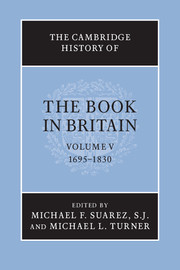Book contents
- Frontmatter
- Introduction
- PART I THE QUANTITY AND NATURE OF PRINTED MATTER
- PART II ECONOMIC, LEGAL AND CULTURAL CONTEXTS
- PART III THE TECHNOLOGIES AND AESTHETICS OF BOOK PRODUCTION
- 7 The technologies of printing
- 8 The industrialization of the paper trade
- 9 A year’s work in the London printing house of the Bowyers
- 10 Book illustration and the world of prints
- 11 The morphology of the page
- 12 Bookbinding in the eighteenth century
- PART IV THE BOOK TRADE AND ITS MARKETS
- V BOOKS AND THEIR READERS
- Abbreviations used in bibliography
- Bibliography
- Index
- Frontispiece
- Plate section
- References
8 - The industrialization of the paper trade
from PART III - THE TECHNOLOGIES AND AESTHETICS OF BOOK PRODUCTION
Published online by Cambridge University Press: 28 September 2010
- Frontmatter
- Introduction
- PART I THE QUANTITY AND NATURE OF PRINTED MATTER
- PART II ECONOMIC, LEGAL AND CULTURAL CONTEXTS
- PART III THE TECHNOLOGIES AND AESTHETICS OF BOOK PRODUCTION
- 7 The technologies of printing
- 8 The industrialization of the paper trade
- 9 A year’s work in the London printing house of the Bowyers
- 10 Book illustration and the world of prints
- 11 The morphology of the page
- 12 Bookbinding in the eighteenth century
- PART IV THE BOOK TRADE AND ITS MARKETS
- V BOOKS AND THEIR READERS
- Abbreviations used in bibliography
- Bibliography
- Index
- Frontispiece
- Plate section
- References
Summary
French imports dominated the British paper trade until the end of the seventeenth century. Protected by tariffs, nurtured by capital investment and sustained by a steady demand for their products, British papermakers learned to manufacture cheap printing grades, drove the French out of the lower end of the market, and competed successfully against higher-quality goods imported from Holland and Italy. During the eighteenth century, they established a completely independent, highly efficient, well-organized and generally prosperous paper trade, ripe for technological innovations.
Scientific discoveries and engineering advances revolutionized their business, but not so thoroughly and not quite so quickly as they claimed. Legal disputes and financial obligations complicated the diffusion of machine technology, which did not consist of any one invention, but rather a series of inventions, each needing the others to achieve its full potential. As far as printers were concerned, this process did not reach its logical conclusion until the advent of rotary presses capable of printing paper in the form of rolls rather than sheets – but in this period web printing was not yet technically feasible (or even legally permissible).
Nevertheless, printers and publishers extolled the economic and cultural benefits of industrialization in terms of one machine, the Fourdrinier, a name used even now to signify progress in the papermaking trade. In 1837, friends of Henry Fourdrinier testified that he deserved recognition and recompense for the sacrifices he had made to develop the machine – not just a labour-saving device but a mechanism for social change, increasing capacity and cutting costs so dramatically that its products could enhance and redirect the power of the printed word. They promised that cheap paper would be a vehicle of learning, that it would bring knowledge, instruction and enlightenment within the reach of readers eager to improve themselves with books previously beyond their means.
- Type
- Chapter
- Information
- The Cambridge History of the Book in Britain , pp. 200 - 217Publisher: Cambridge University PressPrint publication year: 2009
References
- 1
- Cited by

